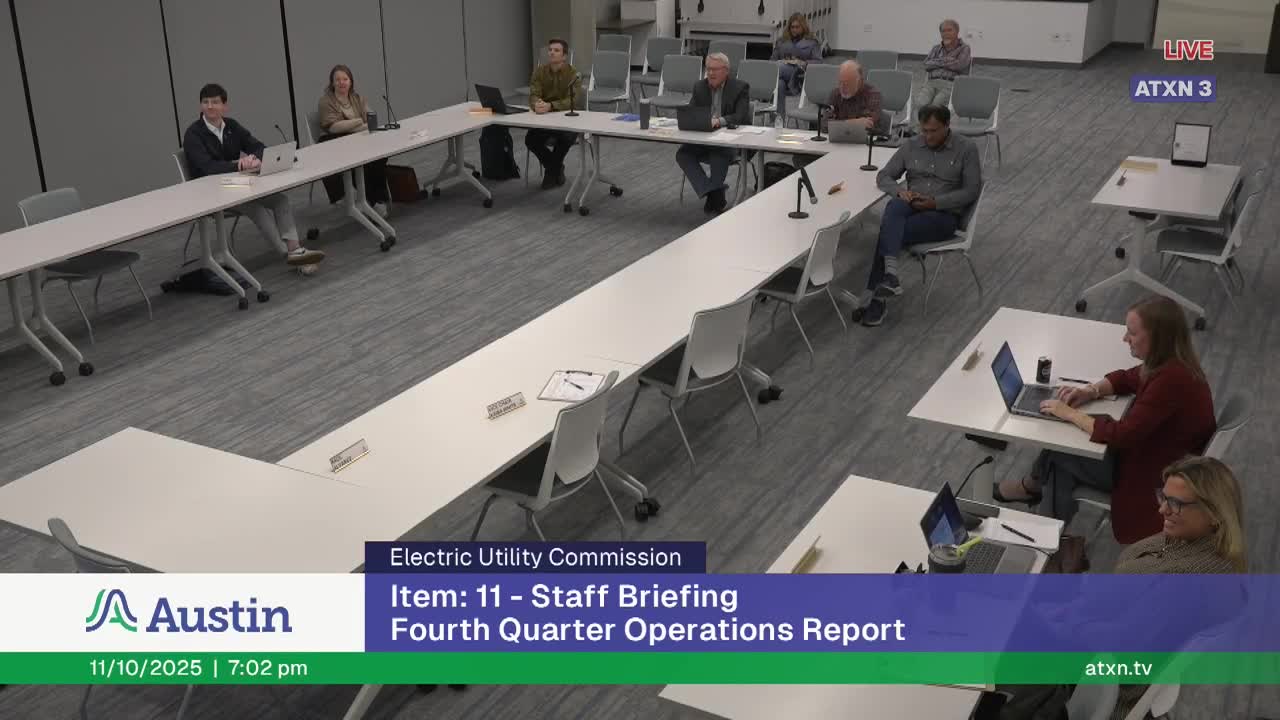Austin Energy unveils 10‑year resiliency plan with $735 million 10‑year forecast, prioritizing overhead hardening over full undergrounding
November 10, 2025 | Austin, Travis County, Texas
This article was created by AI summarizing key points discussed. AI makes mistakes, so for full details and context, please refer to the video of the full meeting. Please report any errors so we can fix them. Report an error »

Austin Energy presented a 10‑year Electric System Resiliency Plan (ESRP) on Nov. 10, emphasizing a strategic, phased approach that prioritizes overhead hardening and targeted technologies to improve reliability and resilience while keeping affordability and equity considerations in view.
Lisa Martin, Austin Energy’s chief operating officer, said the plan draws on two studies — an undergrounding feasibility study and an overhead resiliency study — and explicitly noted that complete undergrounding of roughly 55,000 miles of overhead distribution was estimated at about $50 billion and would face constraints including sensitive environmental and cultural areas, rocky soils and telecom relocation challenges. Martin said the ESRP takes a “crawl, walk, run” approach with a 10‑year horizon and aims for the highest near‑term impact: in year 1 staff propose to harden 20 circuits, inspect about 8,000 poles and deploy roughly 130 smart grid devices; year 2 would scale many of those numbers (40 circuits hardened, about 15,000 poles inspected), and later years would continue roll‑out and transition to maintenance.
Martin framed the strategy as data‑driven and equity focused: “Dollars $50,000,000,000 to underground isn't the best use of funds and the work needs to be highly strategic,” she said, and staff plan to publish dashboards to track progress. She highlighted that overhead hardening, sectionalizing and automation (reclosers and covered conductor in wildfire‑prone areas) are expected to provide faster reliability gains and be more cost‑effective in the near term. The plan included an initial, rough budget forecast of $735,000,000 carried forward from the approved FY26 CIP and O&M budgets across the 10‑year window.
Commissioners asked technical questions about the mix of technologies (reclosers, covered conductor, reinforced poles), program scale (about 400 circuits total in the system), inspection and replacement approaches, and how the plan interfaces with transmission and large‑load planning. Staff said it will return to council and post the plan online after final reviews and present near‑term implementation steps and tracking mechanisms.
Next steps: staff will present the finalized ESRP to the city council, publish the plan and dashboards, and begin mobilizing FY26 initiatives in the plan’s action phase.
Lisa Martin, Austin Energy’s chief operating officer, said the plan draws on two studies — an undergrounding feasibility study and an overhead resiliency study — and explicitly noted that complete undergrounding of roughly 55,000 miles of overhead distribution was estimated at about $50 billion and would face constraints including sensitive environmental and cultural areas, rocky soils and telecom relocation challenges. Martin said the ESRP takes a “crawl, walk, run” approach with a 10‑year horizon and aims for the highest near‑term impact: in year 1 staff propose to harden 20 circuits, inspect about 8,000 poles and deploy roughly 130 smart grid devices; year 2 would scale many of those numbers (40 circuits hardened, about 15,000 poles inspected), and later years would continue roll‑out and transition to maintenance.
Martin framed the strategy as data‑driven and equity focused: “Dollars $50,000,000,000 to underground isn't the best use of funds and the work needs to be highly strategic,” she said, and staff plan to publish dashboards to track progress. She highlighted that overhead hardening, sectionalizing and automation (reclosers and covered conductor in wildfire‑prone areas) are expected to provide faster reliability gains and be more cost‑effective in the near term. The plan included an initial, rough budget forecast of $735,000,000 carried forward from the approved FY26 CIP and O&M budgets across the 10‑year window.
Commissioners asked technical questions about the mix of technologies (reclosers, covered conductor, reinforced poles), program scale (about 400 circuits total in the system), inspection and replacement approaches, and how the plan interfaces with transmission and large‑load planning. Staff said it will return to council and post the plan online after final reviews and present near‑term implementation steps and tracking mechanisms.
Next steps: staff will present the finalized ESRP to the city council, publish the plan and dashboards, and begin mobilizing FY26 initiatives in the plan’s action phase.
View full meeting
This article is based on a recent meeting—watch the full video and explore the complete transcript for deeper insights into the discussion.
View full meeting
